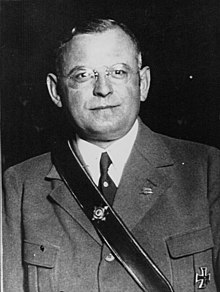Franz Seldte
This article needs additional citations for verification. (December 2008) |
Franz Seldte | |
|---|---|
 Franz Seldte, 1933 | |
| Reich Minister for Labour | |
| In office 30 January 1933 – 23 May 1945 | |
| President |
|
| Chancellor |
|
| Preceded by | Friedrich Syrup |
| Federal Leader of the Nationalsozialistischer Deutscher frontkämpfer-Bund (Stahlhelm) | |
| In office 28 March 1934 – 7 November 1935 | |
| Federal Leader of Der Stahlhelm | |
| In office 25 December 1918 – 28 March 1934 | |
| Personal details | |
| Born | 29 June 1882 Brunswick University of Technology |
| Signature | |
| Military service | |
| Allegiance | |
| Branch/service | Imperial German Army |
| Years of service | 1914–1918 |
| Rank | Hauptmann d.R. |
| Unit | 66th Infantry Regiment |
| Battles/wars | World War I |
| Awards |
|
Franz Seldte (29 June 1882 – 1 April 1947) was a German
Early life and education
Born in
Der Stahlhelm

As a reaction to the German Revolution of 1918–1919, Seldte founded Der Stahlhelm, Bund der Frontsoldaten on 25 December 1918, agitating against the Treaty of Versailles and German war reparations. According to Seldte, the organization was to use the spirit of the Frontsoldaten against the 'swinish revolution' taking place in Germany under the Weimar government.[3] While he took charge of Der Stahlhelm from 1923 onwards, he had to cope with the constant rivalry of his deputy leader, the militant Theodor Duesterberg.
Seldte became a member of the national conservative German National People's Party (DNVP) and was a member of the Magdeburg city council (Stadtrat).[citation needed] During the later years of the
Minister for Labour
During the negotiations for the Chancellorship of Germany between
On 27 April 1933 Seldte finally joined the Nazi Party and merged Der Stahlhelm into
In 1935 Seldte requested to be released from official responsibilities, but Hitler refused. Throughout his tenure as chief of the Labor Ministry, Seldte never enjoyed the full support of Hitler, who did not think he was worth much. As a result, members of the Nazi hierarchy began encroaching on his areas of responsibility and Seldte was marginalized accordingly.
As Reich Minister for Labour, Franz Seldte was one of the signatories of the Work Order Act (Gesetz zur Ordnung der nationalen Arbeit) from 1934, which introduced the Führer principle (Führerprinzip) in factories and significantly restricted the rights of employees.
Death
Seldte was captured at the end of the war and imprisoned in Camp Ashcan in Mondorf-les-Bains.[17] During the Nuremberg trials, Seldte tried to exonerate himself by claiming that he had stood against the dictatorship of Hitler and that he advocated for a two-chamber system of parliamentary governance.[18] His story was not convincing. Seldte died in a US military hospital in April 1947 at Fürth, before the Nuremberg Tribunal had the chance to formally try him on the charges.[3]
Legacy
In Nazi-era Germany, streets were named after him in several German cities, among them his hometown Magdeburg and Leverkusen.[19] In Forst (Lausitz), the football stadium at the water tower was named Franz-Seldte-Kampfbahn.[20] In Oberhausen, the square behind the main railway station was named after him.
References
- ^ a b c Stackelberg (2007). The Routledge Companion to Nazi Germany, p. 243.
- ^ Wistrich (2001). Who's Who in Nazi Germany, p. 232.
- ^ a b c Snyder (1976). Encyclopedia of the Third Reich, p. 320.
- ^ Kershaw (2000). Hitler: 1889-1936, Hubris, p. 310, 356.
- ^ Zentner & Bedürftig 1997, p. 385.
- ^ Longerich (2012). Heinrich Himmler, p. 144.
- ^ Shirer (1990). The Rise and Fall of the Third Reich, p. 184.
- ^ Franz Seldte in the Reichstag Databank. Retrieved 27 May 2023.
- ^ Bracher (1970). The German Dictatorship: The Origins, Structure, and Effects of National Socialism, p. 222.
- ^ Klee (2007). Das Personenlexikon zum Dritten Reich. Wer war was vor und nach 1945, p. 578.
- ^ Zentner & Bedürftig 1997, pp. 913–914.
- ^ Protokolle des preußischen Staatsministeriums (Acta Borussica) Band 12/II (1925–1938) p. 757 (PDF; 2,14 MB)
- ^ Lilla 2005, p. 295.
- ^ Fischer (1995). Nazi Germany: A New History, p. 315.
- ^ Evans (2006). The Third Reich in Power, p. 358.
- ^ Mazower (2009). Hitler's Empire: How the Nazis Ruled Europe, pp. 532–533.
- ISBN 9783428528622.
- ^ Taylor & Shaw (2002). Dictionary of the Third Reich, p. 261.
- ^ Franz-Seldte-Str. (ehemalig)
- ISBN 3-935881-21-5.
Bibliography
- Bracher, Karl D. The German Dictatorship: The Origins, Structure, and Effects of National Socialism. New York: Praeger Publishers, 1970.
- Evans, Richard J. The Third Reich in Power. New York: Penguin, 2006.
- Fischer, Klaus. Nazi Germany: A New History. New York: Continuum, 1995.
- Kershaw, Ian. Hitler: 1889-1936, Hubris. New York: W. W. Norton & Company, 2000.
- Klee, Ernst. Das Personenlexikon zum Dritten Reich. Wer war was vor und nach 1945. Frankfurt-am-Main: Fischer-Taschenbuch-Verlag, 2007.
- Lilla, Joachim (2005). Der Prußische Staatsrat 1921–1933: Ein biographisches Handbuch. Düsseldorf: Droste Verlag. ISBN 978-3-770-05271-4.
- Longerich, Peter. Heinrich Himmler. Oxford and New York: Oxford University Press, 2012.
- Mazower, Mark. Hitler's Empire: How the Nazis Ruled Europe. New York: Penguin, 2009.
- Shirer, William L. The Rise and Fall of the Third Reich. New York: MJF Books, 1990, [1959].
- Snyder, Louis L. Encyclopedia of the Third Reich. London: Robert Hale, 1976
- Stackelberg, Roderick. The Routledge Companion to Nazi Germany. New York: Routledge, 2007.
- Taylor, James, and Warren Shaw. Dictionary of the Third Reich. New York: Penguin, 2002.
- Wistrich, Robert S. Who's Who in Nazi Germany. New York: Routledge, 2001.
- Zentner, Christian; Bedürftig, Friedemann, eds. (1997) [1991]. ISBN 978-0-306-80793-0.
External links
- Franz Seldte at Find a Grave
- Newspaper clippings about Franz Seldte in the 20th Century Press Archives of the ZBW
- Information about Franz Seldte in the Reichstag database
